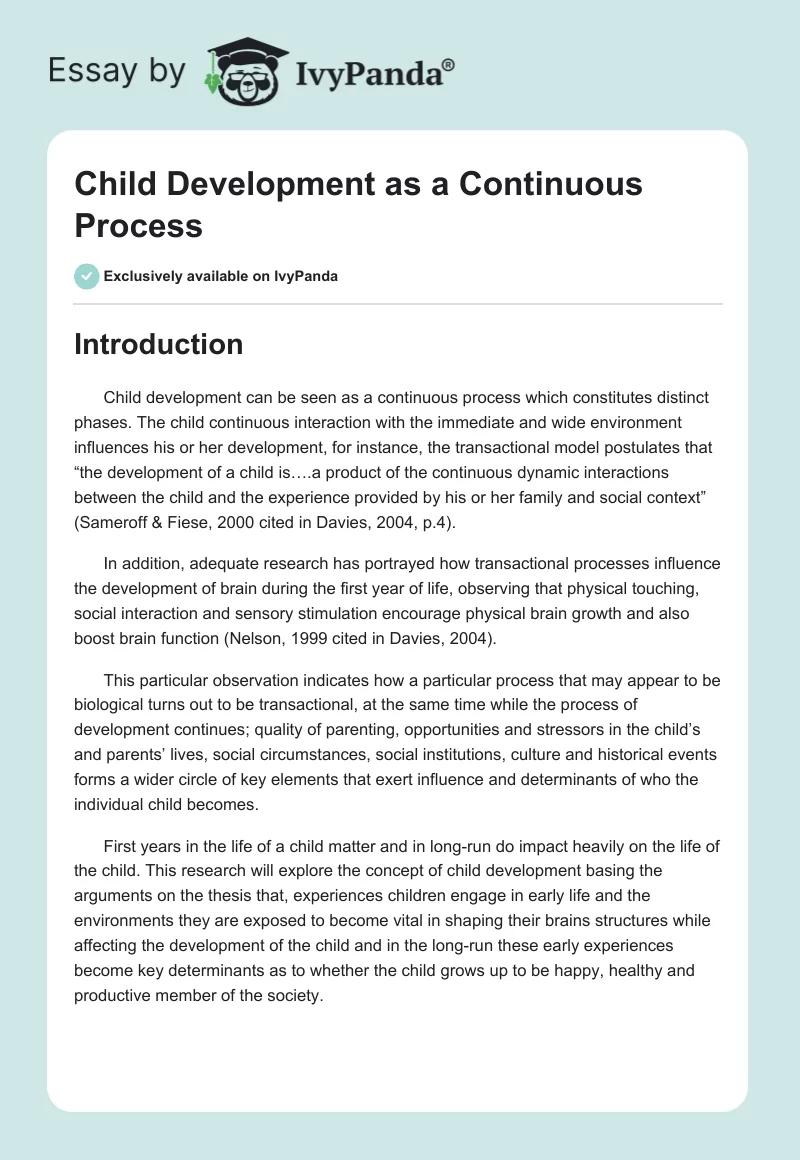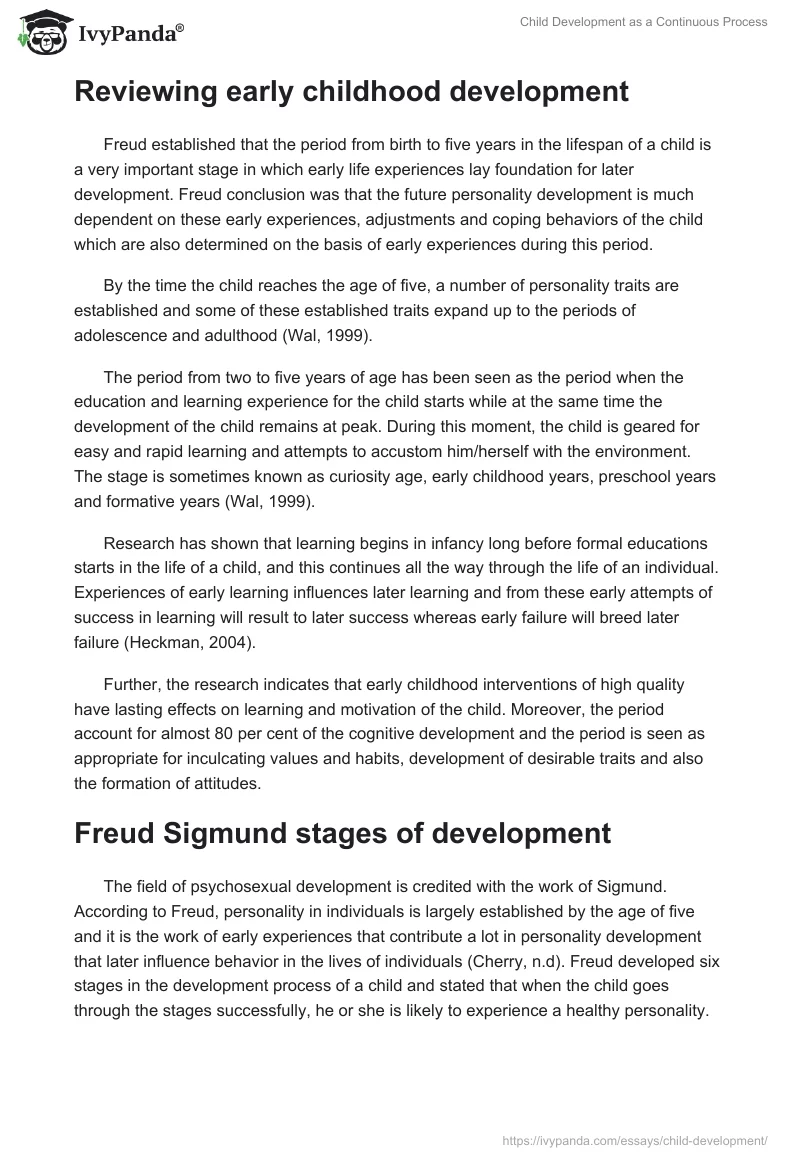Introduction
Child development can be seen as a continuous process which constitutes distinct phases. The child continuous interaction with the immediate and wide environment influences his or her development, for instance, the transactional model postulates that “the development of a child is….a product of the continuous dynamic interactions between the child and the experience provided by his or her family and social context” (Sameroff & Fiese, 2000 cited in Davies, 2004, p.4).
In addition, adequate research has portrayed how transactional processes influence the development of brain during the first year of life, observing that physical touching, social interaction and sensory stimulation encourage physical brain growth and also boost brain function (Nelson, 1999 cited in Davies, 2004).
This particular observation indicates how a particular process that may appear to be biological turns out to be transactional, at the same time while the process of development continues; quality of parenting, opportunities and stressors in the child’s and parents’ lives, social circumstances, social institutions, culture and historical events forms a wider circle of key elements that exert influence and determinants of who the individual child becomes.
First years in the life of a child matter and in long-run do impact heavily on the life of the child. This research will explore the concept of child development basing the arguments on the thesis that, experiences children engage in early life and the environments they are exposed to become vital in shaping their brains structures while affecting the development of the child and in the long-run these early experiences become key determinants as to whether the child grows up to be happy, healthy and productive member of the society.
Reviewing early childhood development
Freud established that the period from birth to five years in the lifespan of a child is a very important stage in which early life experiences lay foundation for later development. Freud conclusion was that the future personality development is much dependent on these early experiences, adjustments and coping behaviors of the child which are also determined on the basis of early experiences during this period.
By the time the child reaches the age of five, a number of personality traits are established and some of these established traits expand up to the periods of adolescence and adulthood (Wal, 1999).
The period from two to five years of age has been seen as the period when the education and learning experience for the child starts while at the same time the development of the child remains at peak. During this moment, the child is geared for easy and rapid learning and attempts to accustom him/herself with the environment. The stage is sometimes known as curiosity age, early childhood years, preschool years and formative years (Wal, 1999).
Research has shown that learning begins in infancy long before formal educations starts in the life of a child, and this continues all the way through the life of an individual. Experiences of early learning influences later learning and from these early attempts of success in learning will result to later success whereas early failure will breed later failure (Heckman, 2004).
Further, the research indicates that early childhood interventions of high quality have lasting effects on learning and motivation of the child. Moreover, the period account for almost 80 per cent of the cognitive development and the period is seen as appropriate for inculcating values and habits, development of desirable traits and also the formation of attitudes.
Freud Sigmund stages of development
The field of psychosexual development is credited with the work of Sigmund. According to Freud, personality in individuals is largely established by the age of five and it is the work of early experiences that contribute a lot in personality development that later influence behavior in the lives of individuals (Cherry, n.d). Freud developed six stages in the development process of a child and stated that when the child goes through the stages successfully, he or she is likely to experience a healthy personality.
The oral stage forms the primary stage where the child interacts with the environment through mouth, hence rooting and sucking becomes important. Success of this stage will see the child develop a sense of trust and comfort while the failure in this stage will lead to dependency and aggression resulting in later problems like drinking, eating, smoking and nail biting (Cherry, n.d).
The anal stage is the focus on libido and how the child controls bladder and bowel movements. The parents become the main teachers in toilet training and whereby using praise and some form of rewards encourage the child in attaining positive outcomes.
Indeed, the success of this stage in later life makes the child to become competent, productive and full of creativity (Cherry, n.d). The phallic stage is where the children develop the ability to recognize the difference between males and females, and through proper training they identify their roles by copying from their parents.
The latent period generally becomes the stage of exploration where the children engages in forming peer relationships, identifying their hobbies and other interest and when successful executed the child develops key social and communication skills while at the same time becoming self-confident (Cherry, n.d). The last stage is the genital stage where the individual develops interests in others and success of the stage is where the individual becomes well-balanced, warm and caring to others (Cherry, n.d).
Early life experiences and brain development
When the child is born, the brains are not fully constructed and it is through experiences which form the architecture that in turn determine how ‘blueprints’ are turned into reality. Basically, the development of brain is interaction between the genes the child is born with and the experiences the child receives from the environment (Deiner, 2009, p.168); and therefore, the early experiences shape not only the behaviors of the child but also the brain of the child.
The deduction from this is that, brain development in a child is an interaction between nature and nurture, while aspects like trauma, disease and abuse together with neglect have the potential to change the brain (Deiner, 2009, p.168).
At the same time, positive influences can also change the brains whereby an enriched, motivating environment has the capability to change the brains of a child both in the areas of cognitive development and also the social development. Davies observes that after birth, child brain growth and the specific ways brain functions are generally organized and subject to the influence of the child’s environment (Davies, 2004, p.140).
Early childhood experience influences which neural pathways will be strengthened, which remain available and which will atrophy and therefore the stimulation the child gets enhances his or her brain development while understimulation, poor and traumatizing environment will greatly hold back or shape brain functioning in maladaptive ways.
On the other part, McCain and Mustard, noted that, “the effects of early experience on the wiring and sculpting of the brain’s billions of neurons last a lifetime” (McCain and Mustard, 1999, cited in Young and Richardson, 2007, p.255).
From this explanation it is evident that: brain development is a continuous process, and that each developmental step influences the next step; the sequence of brain development that relates to experience is hierarchical and occurs in a series of stages and that the sensing pathways develop very early and connect with other pathways to influence learning, behavior and physical and mental health; negative together with the positive experiences in early life greatly affect the development of neural circuits that intercede cognitive, emotional and social capacities; and lastly, child’s early development has important effects on later physical and mental health risks as well as education and learning (Young and Richardson, 2007, p.256).
Conclusion
Therefore from analyzing various and related studies it becomes evident that early childhood experiences have the potential to shape what kind of individuals the child will develop into. All that happens in the life of a child present themselves as important aspects that influence and determine the course of life of the child in his or her later life.
It takes both qualitative and quantitative aspects of early life experiences that the child is exposed to in order to define and mould his or her later life. For instance, a child who experiences early life instances of uncaring, alienating or hostile environment are likely to exhibit higher risk to psychological disorder, participate in disorder and substance abuse and the likelihood they are faced with to fail in life.
At the same time a child who gets early life experience to sports and play is much likely to develop and appreciate sports in his or her life. To conclude, it can be stated that, early childhood forms a critical stage and period in the life of a child since it is during this period that the child acquires many skills that help him or her to become a productive and happy adult since the experiences forms a lasting impact on the life of such a child.
References
Cherry, K. Freud’s Stages of Psychosexual Development. Web.
Davies, D. (2004). Child development: a practitioner’s guide. NY, Guilford Press. Web.
Deiner, P. L. (2009). Inclusive Early Childhood Education: Development, Resources, and Practice. CA, Cengage Learning. Web.
Heckman, J. J. (2004). Investing in the Very Young: Importance of early childhood development. Encyclopedia on Early Childhood Development. Web.
Wal, S. (1999). Encyclopaedia of Child Development: Priorities for 21st Century. New Delhi, Sarup & Sons. Web.
Young, M. E. and Richardson, L. M. (2007). Early child development from measurement to action: a priority for growth and equity. VA, World Bank Publications. Web.


